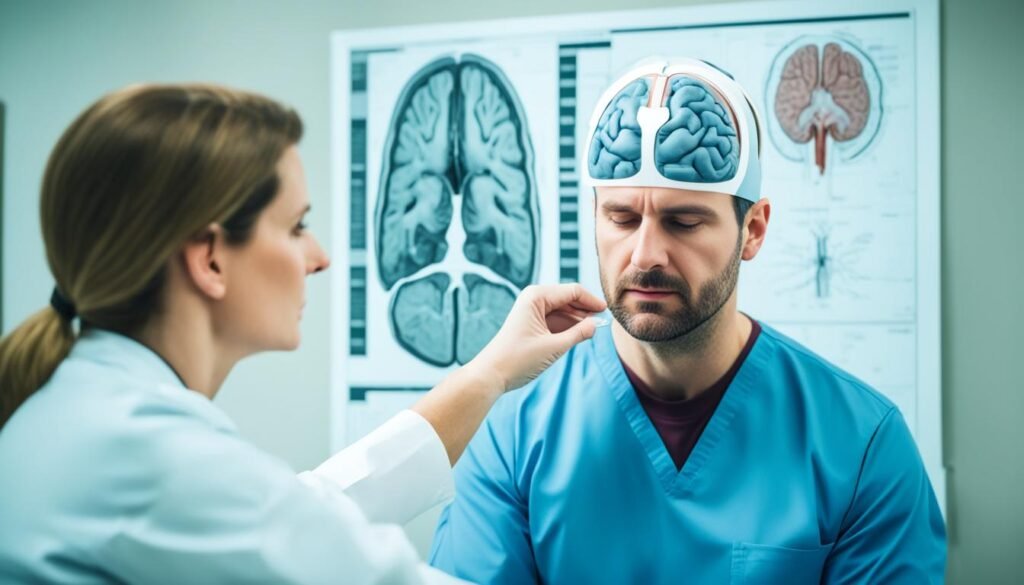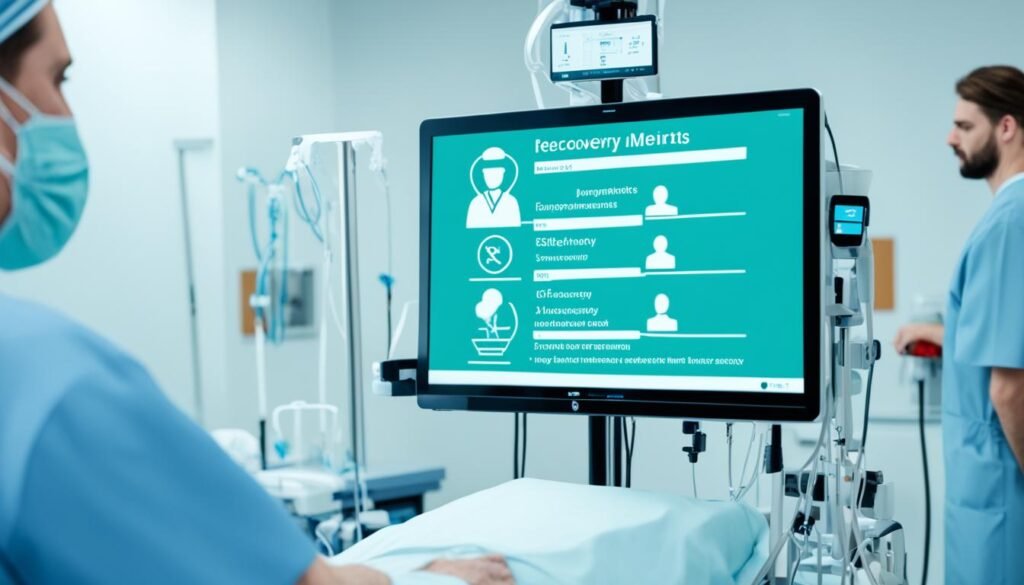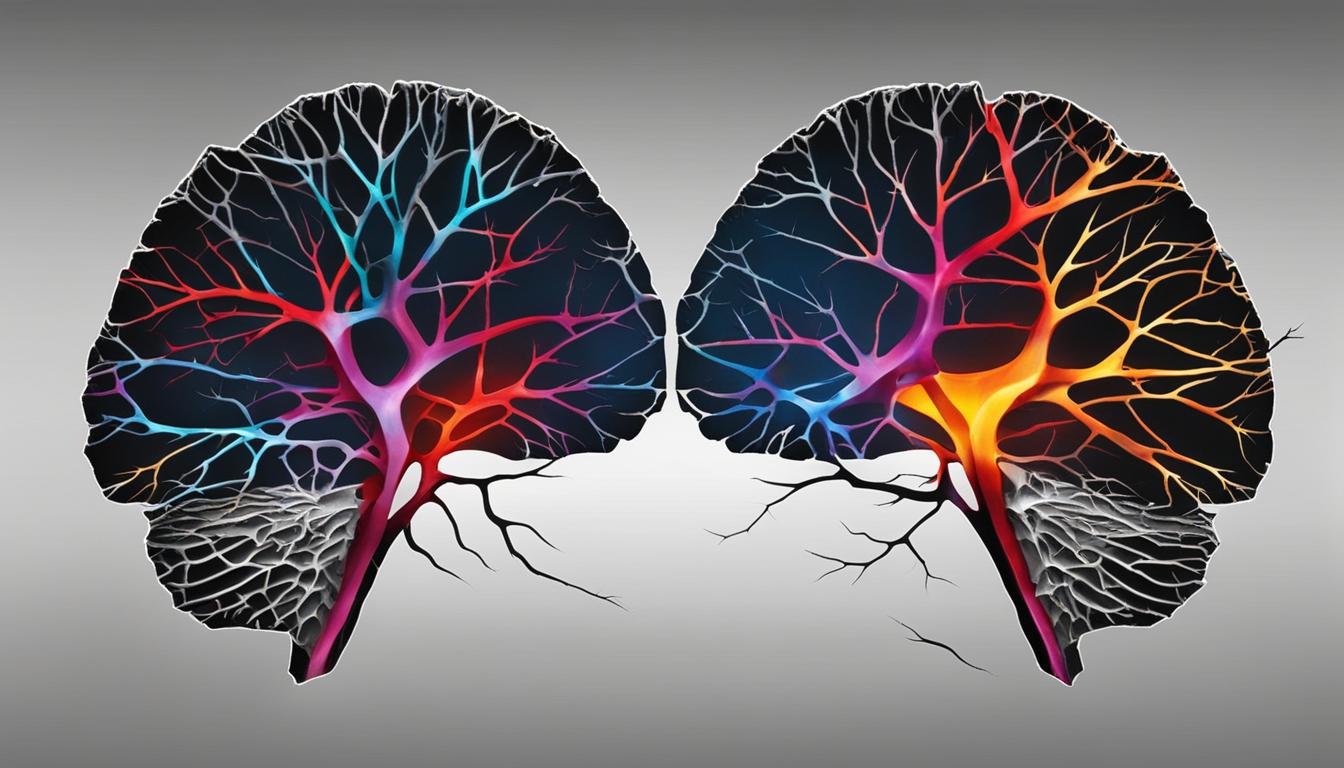Did you know about 2.8 million people in the United States get a traumatic brain injury (TBI) every year?
Traumatic brain injury happens with a hard hit to the head or body. This can cause temporary problems in brain cells or physical harm. Fall, vehicle crashes, sports injuries, and blasts are common reasons for TBI.
We will talk about what symptoms TBI has, why it happens, and who is at risk. We will also look into how it is diagnosed and what treatments and rehabilitation are possible. If you or someone close has had a serious hit to the head or body, getting medical help fast is critical.
Key Takeaways:
- About 2.8 million people in the US face traumatic brain injury each year.
- Many things lead to TBI, like falls, vehicle crashes, violence, and sports injuries.
- It is vital to get medical help right away after a head or body trauma.
- Symptoms of TBI can be mild like headaches or serious like seizures.
- To diagnose TBI, doctors may check medical history, do a physical exam, and use imaging tests such as CT or MRI scans.
Recognizing the Symptoms of Traumatic Brain Injury
Traumatic brain injury (TBI) symptoms can range with the injury’s severity. It’s key to know the signs of TBI to get the right medical help. Mild TBI symptoms include:
- Headaches
- Nausea
- Dizziness
Some people may also have blurred vision, sensitivity to light or sound. And cognitive and behavioral issues like:
- Memory problems
- Mood swings
- Difficulty sleeping
For moderate to severe TBI, the symptoms can be more intense, like:
- Loss of consciousness
- Repeated vomiting
- Seizures
- Weakness or numbness in limbs
- Changes in behavior or speech
If you have these symptoms after a trauma, get medical help right away. Spotting these signs early can help with a correct diagnosis and treatment. The quicker you get medical help, the better your recovery chances.
Ignoring any TBI symptoms can lead to long-term harm. All impacts to the head or body should be taken seriously. Seek a medical checkup to ensure your health. Your well-being deserves the care needed for complete healing.
Causes and Risk Factors of Traumatic Brain Injury
Traumatic brain injury (TBI) can happen from falls, vehicle crashes, violence, and more. These are the main causes of TBI. They lead to different levels of brain damage.
Age is a big factor in the risk for TBI. Kids and young adults, as well as those over 60, are at higher risk. Their brains are more vulnerable to injuries.
Gender also plays a role, with males often doing riskier activities. However, TBI can occur to anyone, no matter their age or gender.
Certain activities, like football or boxing, increase TBI chances due to hits to the head. Extreme sports also have a high risk for brain injuries.
“Prevention is key when it comes to traumatic brain injury. By taking precautions and following safety guidelines, you reduce the risk.” – Dr. Sarah Thompson, Neurologist
Preventing Traumatic Brain Injury
To prevent TBIs, wear protective gear like helmets in sports. They lessen the impact on the head and help avoid serious injuries.
It’s also vital to follow safety rules and use seatbelts in cars. For kids, using the right car seats is important.
Diagnosing Traumatic Brain Injury
Diagnosing a traumatic brain injury (TBI) involves multiple steps. It includes reviewing medical history, performing a physical check, and using diagnostic tests. This approach helps doctors make quick, correct diagnoses. Getting it right is crucial for treating and managing the injury properly.
Medical History and Physical Examination
First, doctors collect detailed medical history and learn about the injury event. They want to know how the injury happened, any consciousness loss, symptom presence, and past head injuries. Then, a thorough physical exam is done. This checks the patient’s neurological functions and looks for brain injury signs.
The Glasgow Coma Scale
The Glasgow Coma Scale (GCS) measures brain injury severity. It evaluates eye, verbal, and motor responses and gives a score from 3 to 15. A lower score means a more severe injury. The GCS score helps decide the patient’s consciousness level, guiding further actions and treatment.
Diagnostic Imaging Tests
Imaging tests are key in diagnosing TBI. The two main tests are:
- CT scan (Computed Tomography): Uses X-rays for detailed brain images. It spots bleeding, skull fractures, and more.
- MRI scan (Magnetic Resonance Imaging): Uses magnetic fields for detailed images. It shows brain tissue damage and swelling.
Intracranial Pressure Monitoring
In certain cases, doctors monitor pressure inside the skull with an intracranial pressure monitor. High pressure can mean brain swelling or bleeding, needing urgent care. This test places a device inside the skull for accurate pressure readings.
Through medical history, physical exams, and diagnostic tests, doctors diagnose TBI. They can then plan the best treatment.

| Diagnostic Tools for Traumatic Brain Injury | Advantages | Limitations |
|---|---|---|
| Glasgow Coma Scale | – Quick and easy to administer – Provides an initial assessment of injury severity |
– Subjective scoring – Does not provide detailed information about brain abnormalities |
| CT scan | – Able to detect bleeding, fractures, and other structural abnormalities – Fast and widely accessible |
– Involves radiation exposure – Less detailed than MRI |
| MRI scan | – Provides detailed images of brain structures – Can detect brain tissue damage and swelling |
– Lengthy scanning time – May not be suitable for individuals with metal implants or claustrophobia |
| Intracranial Pressure Monitoring | – Identifies elevated pressure levels, indicating the need for intervention – Direct measurement of intracranial pressure |
– Invasive procedure – Requires specialized equipment and expertise |
Treatment and Rehabilitation for Traumatic Brain Injury
The treatment for traumatic brain injury (TBI) depends on how severe it is. Mild TBI might only need rest and some painkillers you can buy without a prescription. But, moderate to severe TBI needs quick medical help. This is to keep the person stable and prevent more brain damage.
Doctors might give medicines like anti-seizure drugs and diuretics for TBI. These medicines help stop seizures and lower swelling in the brain.
Rehab is key for recovering from TBI. It often includes different types of therapy. Physical therapy helps get back strength and movement. Occupational therapy helps people relearn daily skills.
Speech therapy is for issues with talking and swallowing. Trained therapists work with patients to better their speech and swallowing. They use special exercises and techniques.

Rehab aims to make life better for people with TBI. Programs are made just for them. They might include training for the mind, help with getting a job, and emotional support.
People with TBI should follow their treatment plan closely. They should work with their doctors and therapists. With the right care and rehab, they can see big improvements in their health.
Conclusion
Traumatic brain injury (TBI) is serious and affects people deeply. It changes physical, cognitive, and emotional states. Quick action and treatment help recovery a lot.
Treatment includes rest, medication, and therapy. Rest heals the brain after injury. Medication eases symptoms and prevents problems. Rehabilitation therapies like physical, occupational, and speech help people get back abilities and improve life skills.
With the right care, people with TBI can get much better. Their life quality can improve greatly. But, getting medical help and following a full treatment plan are key. Treatment and rehab are important for healing and getting better. If you know someone with a TBI, get them the help they need fast for the best recovery.

